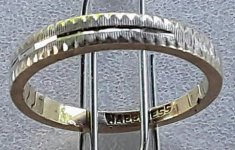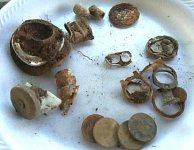Fantastic info and exactly what I was looking for! I read that darn manual section at least 20 times and it just never made sense in my head until spelled out here. Ended up making a 5 tone setup like some of the coinshooter setups people have had listed out there which seemed to work fairly well. With the 50 tones I almost have to watch the numbers constantly, but now may experiment a bit with it to see if I can find a sweet spot for me with those 2 tone settings.
I use 5 tones in my trashed out parks and I found this setting to be very helpful.
I set 11-13 as a high tone and loud, I love to find nickels, (and nickel area gold), of any kind and they usually come in pretty solid as a 12 or 13 on my Nox in my soil and I also have a million hours on an F70 which can change the nickel section to high tones like dimes.
I have found a ton of nickels using this and some nickel area gold, too, using this handy feature so I use the Nox in a similar manner.
Not always but most of the time nickels are a 12-13, 13 mostly and solid...I have dug a few at 11, too, and very deep ones in mineralized dirt or near iron have the possibility to up-average right out of this range.
What I also deal with are about a million tabs of all kinds where they usually start coming in at 14-15, the bane of my existence.
At 14 I keep the volume high but lower the tone way down, 14-17 range or so, maybe 18 but much higher you could be into Indian territory and I would hate to miss those.
Luckily, in my red clay mineralized SE. dirt Indians usually up-average to 21-23 but still...
With the very noticeable tone break between 13 and 14 I still find plenty of nickels but almost every signal that jumps from 13-14 or to 15 to higher have mostly been tabs for me since I bought this thing and avoiding them is my goal.
Some tabs come in solid in the nickel range and don't jump at all but most do, luckily.
When scanning I listen for that tone jump from high to low as it goes from 13 to the next few numbers, easy peasy and no need to even look at the screen I just dismiss them and move on fast and efficient like.
I used to dig tons of these signals making sure at first, now I have the confidence if I get a 12 or 13 and it jumps higher to 14 or more of it I hear that tone jump up and down it ain't a nickel.
Other junk can jump from 12-13 to even higher.
Of course you never know, good targets can jump like this under some circumstances too but so far for me nothing good has ever come up that did.
This helps me avoid a ton of time of useless digging and let's me concentrate on looking for better, more stable signals that actually could be good targets.
This works, for me, anyway.
Recently I was hunting my local trashed out park in an area I had searched a million times for years, using the standard coil and this 5 tone setup.
I hit a spot with lots of jumping, trash all around like can slaw or foil in the lower numbers and if I remember at least one of those 13 to higher jumps which I assume was a tab.
Despite all that I noticed a solid high tone and a 12 that stayed in the screen if I moved the coil slightly side to side in very short movements.
Turned 90 degrees and did it again, jumping all around but in one tiny spot with short side to side sweeps I got that solid high tone and that 12 number to stay.
Dug the thing, got happy....the solid 12 was a small 14k gold ring.
At least 5 pieces of trash surrounded this thing close but the Nox, even with the standard coil, saw it and my high tone nickel setting made me notice it.
I don't watch the screen as I hunt, I listen first and if I hear something interesting, solid and repeating then I look so the short solid high tone worked.
Below the ring is all the other mostly solid nickel area targets I dug on this same hunt.
Notice there are 4 actual nickels in there, also.
Ya gotta sift through the trash to find the treasure and you need to set your detector to let you know in the most efficient way possible that you found some.




